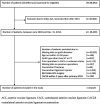Graft Fixation and Timing of Surgery Are Predictors of Early Anterior Cruciate Ligament Revision: A Cohort Study from the Swedish and Norwegian Knee Ligament Registries Based on 18,425 Patients
- PMID: 32043061
- PMCID: PMC6959909
- DOI: 10.2106/JBJS.OA.19.00037
Graft Fixation and Timing of Surgery Are Predictors of Early Anterior Cruciate Ligament Revision: A Cohort Study from the Swedish and Norwegian Knee Ligament Registries Based on 18,425 Patients
Abstract
The identification of surgical risk factors for early anterior cruciate ligament (ACL) revision is important when appropriate treatment for patients undergoing primary ACL reconstruction is selected. The purposes of this study were to determine the short-term ACL revision rate of patients undergoing primary ACL reconstruction and to identify surgical risk factors for ACL revision within 2 years of primary ACL reconstruction.
Methods: This study was based on data collected prospectively from the Norwegian and Swedish National Knee Ligament Registries. Patients who underwent primary ACL reconstruction from 2004 through 2014 were included. We examined revisions through 2016. The relative risks (RRs) of revision ACL reconstruction dependent on graft fixation, the time interval between injury and surgical procedure, and meniscal and cartilage injury were estimated by using generalized linear models with a binomial distribution and log-link function. The outcome was set as revision ACL reconstruction during the first 2 years.
Results: A total of 58,692 patients were assessed for eligibility; of these, 18,425 patients were included. The overall 2-year revision rate was 2.1%. Patients treated with a metal interference screw had an increased risk of ACL revision when compared with patients who were treated with other femoral fixations (RR, 1.78 [95% confidence interval (CI), 1.38 to 2.29]; p < 0.001). The use of the RIGIDFIX Cross Pin System (DePuy Synthes) entailed a lower risk of ACL revision compared with other femoral fixations (RR, 0.58 [95% CI, 0.42 to 0.82]; p = 0.0017). Patients undergoing ACL reconstruction within 3 months of the injury had an increased risk of ACL revision (RR, 2.07 [95% CI, 1.64 to 2.61]; p < 0.001).
Conclusions: Patients undergoing ACL reconstruction within 3 months of an injury, as well as patients treated with a metal interference screw in the femur, had a significantly higher risk of ACL revision, and patients treated with the RIGIDFIX Cross Pin in the femur had a significantly lower risk of ACL revision.
Level of evidence: Prognostic Level II. See Instructions for Authors for a complete description of levels of evidence.
Copyright © 2019 The Authors. Published by The Journal of Bone and Joint Surgery, Incorporated. All rights reserved.
Figures




Similar articles
-
Graft Diameter and Graft Type as Predictors of Anterior Cruciate Ligament Revision: A Cohort Study Including 18,425 Patients from the Swedish and Norwegian National Knee Ligament Registries.J Bone Joint Surg Am. 2019 Oct 16;101(20):1812-1820. doi: 10.2106/JBJS.18.01467. J Bone Joint Surg Am. 2019. PMID: 31626005
-
Surgical Predictors of Early Revision Surgery After Anterior Cruciate Ligament Reconstruction: Results From the Swedish National Knee Ligament Register on 13,102 Patients.Am J Sports Med. 2014 Jul;42(7):1574-82. doi: 10.1177/0363546514531396. Epub 2014 Apr 28. Am J Sports Med. 2014. PMID: 24778266
-
The Influence of Graft Fixation Methods on Revision Rates After Primary Anterior Cruciate Ligament Reconstruction.Am J Sports Med. 2018 Mar;46(3):524-530. doi: 10.1177/0363546517748924. Epub 2018 Jan 16. Am J Sports Med. 2018. PMID: 29337596
-
Factors associated with revision following anterior cruciate ligament reconstruction: A systematic review of registry data.Knee. 2020 Mar;27(2):287-299. doi: 10.1016/j.knee.2019.12.003. Epub 2020 Jan 31. Knee. 2020. PMID: 32014408
-
Press-fit fixation in anterior cruciate ligament reconstruction yields low graft failure and revision rates: a systematic review and meta-analysis.Knee Surg Sports Traumatol Arthrosc. 2021 Jun;29(6):1750-1759. doi: 10.1007/s00167-020-06173-4. Epub 2020 Aug 12. Knee Surg Sports Traumatol Arthrosc. 2021. PMID: 32785757
Cited by
-
Outcomes of RigidFix Cross Pin Fixation in Femoral and Tibial Tunnel for Anterior Cruciate Ligament Reconstruction.Orthop Surg. 2024 Feb;16(2):337-345. doi: 10.1111/os.13934. Epub 2023 Dec 13. Orthop Surg. 2024. PMID: 38088239 Free PMC article.
-
Ensemble Algorithm for Risk Prediction of Clinical Failure After Anterior Cruciate Ligament Reconstruction.Orthop J Sports Med. 2024 Aug 19;12(8):23259671241261695. doi: 10.1177/23259671241261695. eCollection 2024 Aug. Orthop J Sports Med. 2024. PMID: 39165332 Free PMC article.
-
No Effect of Return to Sport Test Batteries with and without Psychological PROs on the Risk of a Second ACL Injury: A Critical Assessment of Four Different Test Batteries.Int J Sports Phys Ther. 2023 Aug 1;18(4):874-886. doi: 10.26603/001c.81064. eCollection 2023. Int J Sports Phys Ther. 2023. PMID: 37547843 Free PMC article.
-
No difference in ACL revision rates between hamstring and patellar tendon autograft in patients with ACL-R and a concurrent meniscal injury irrespective of meniscal treatment.Knee Surg Sports Traumatol Arthrosc. 2025 Jul;33(7):2422-2437. doi: 10.1002/ksa.12592. Epub 2025 Jan 23. Knee Surg Sports Traumatol Arthrosc. 2025. PMID: 39844666 Free PMC article.
-
Acute and subacute anterior cruciate ligament reconstructions are associated with a higher risk of revision and reoperation.Knee Surg Sports Traumatol Arthrosc. 2022 Oct;30(10):3311-3321. doi: 10.1007/s00167-022-06912-9. Epub 2022 Feb 24. Knee Surg Sports Traumatol Arthrosc. 2022. PMID: 35201372
References
-
- Middleton KK, Hamilton T, Irrgang JJ, Karlsson J, Harner CD, Fu FH. Anatomic anterior cruciate ligament (ACL) reconstruction: a global perspective. Part 1. Knee Surg Sports Traumatol Arthrosc. 2014. Jul;22(7):1467-82. Epub 2014 Feb 5. - PubMed
-
- Frobell RB, Roos HP, Roos EM, Roemer FW, Ranstam J, Lohmander LS. Treatment for acute anterior cruciate ligament tear: five year outcome of randomised trial. Br J Sports Med. 2015. May;49(10):700. - PubMed
LinkOut - more resources
Full Text Sources
Research Materials
